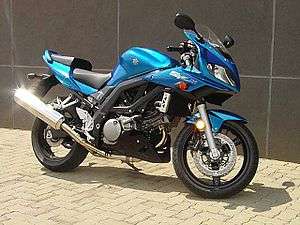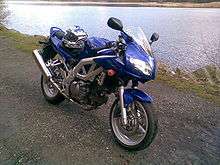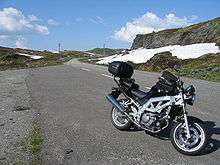Suzuki SV650
The Suzuki SV650 and variants are street motorcycles manufactured since 1999 for the international market by the Suzuki Motor Corporation, featuring a mid-sized V-twin engine and medium performance components. In 2009, Suzuki replaced the naked SV650 with the SFV650 Gladius. In 2016, the Gladius name was discontinued and the 2017 model was reverted to SV650.
 2006 Suzuki SV650S | |
| Manufacturer | Suzuki |
|---|---|
| Production | 1999–2012 2016–present |
| Class | Standard (SV650), sport bike (SV650S)[1] |


.jpg)
First generation (1999–2002)
Suzuki introduced the SV650 in 1999 as a budget entry in the emerging naked bike market and featured both naked and fully faired versions.[2] The bike provided a sporty though easily manageable ride. The combination of light weight, rigid chassis, strong handling, and the V-twin's strong mid-range torque appealed to beginner and experienced riders alike. The 2003 SV1000 was marketed as a bigger alternative to the second generation SV650.
The SV650 immediately became popular, but American buyers wanted the sportier 'S' version that featured lower handlebars, higher foot pegs and a bikini fairing and windscreen, available only in the European and Canadian markets. American magazines ran articles describing how to import it into the United States. In 2000, Suzuki began importing the SV650S to the USA.
The SV650 with its relatively low purchase price and excellent handling characteristics became popular with racers which prompted a rebirth of the "lightweight twins" racing classes across North America and the SV650 began outselling the Suzuki GS500, Honda NT650 and Kawasaki Ninja 500R, which previously populated the class.
Second generation (2003–2012)
In 2003, Suzuki redesigned the SV650 with a new pressure-cast aluminum truss frame, bodywork, swing-arm with revised rear brake caliper mounting, exhaust, digital speedometer display and electronic fuel injection/induction system to replace the carburetor.
The 2003 SV650s also supported some first generation parts (like the rearsets and radiator). The subframe is also angled up higher than 2004+ models. The different subframe has year-specific parts, such as the rider seat, plastic frame covers, exhaust hanger brackets and passenger pegs.
For 2004, Suzuki used a new, 40 mm lower subframe and a seat with a narrower design in the front. This made flat footing easier for shorter riders. The trail was raised by 2 mm, and the rear fender was restyled to clean up the area under the tail lights and provide more protection against flying debris.
In 2005, the color of the frame was changed from silver to a matte black finish and the radiator size was decreased from 440 to 410 mm (17 to 16 in).
For 2007, both SV650 and SV650S added dual spark plugs per cylinder, and an exhaust gas oxygen sensor on California models for reduced emissions. An anti-lock braking system (ABS) was also added as an option.
For 2008, alongside the traditional SV650 and SV650S models, Suzuki offered a new SV650 Sport (UK) or SV650SF (US) model with a more traditional complete fairing. The SV650S was removed from the US market.
In September 2008, Suzuki Australia introduced the SV650SU, a de-tuned version of the SV650S, to augment their range of motorcycles that comply with the country's Learner Approved Motorcycle Scheme (LAMS).[3]
The 2009 Suzuki SFV650 Gladius replaced the SV650 naked version in the USA; however, a naked 2009 SV650 was available in Canada. Although the naked version was superseded by the Gladius, the SV650S model remained in the UK and Australian line-up through to 2012.[4]
Third generation (2017)
The 2017 model released in 2016, SV650/A has returned to the more conventional styling of the pre Gladius naked version. Suzuki claims the wet weight for the non-ABS model is 195 kg(430 lbs) wet and 197 kg (434 lbs) for the ABS model. Its engine develops an additional four horse power and features a low-speed stalling prevention system (low RPM assist) to make the bike more suited to beginners and easier to ride in stop/go traffic. It meets Euro 4 emission regulations. It has a new, slim, steel frame. Seat height is 785mm(30.9"). Fuel tank capacity is 13.8 litres or 15.5 litres in the US market. It has twin front disc brakes, and new 39mm slimmer and lighter throttle bodies.[5] In November 2015 Suzuki announced[6] at EICMA 2015 that the SV650 would return in 2016 as a 2017-model year product.[7][8] Preload adjusters are fitted to 2018 models.[9]
Current market situation
Motorcycles with comparable motor characteristic are Honda CB650F / Honda CBR650F, Kawasaki ER-6n / Kawasaki Ninja 650, Yamaha FZ6R and Yamaha MT-07 and it is, with similar performance specifications, much more affordable than the likes of the Ducati Scrambler and KTM 690 Duke.[10][11]
Specifications
| Model year | 1999-2002 | 2003 | 2004-2006 | 2007 | 2008-2014 | 2017 |
|---|---|---|---|---|---|---|
| Suzuki Year Codes | X ('99), Y ('00), K1, K2 | K3 | K4, K5, K6 | K7 | K8, K9, L0, L1, L2, L3, L4 | |
| Suzuki Models | SV650 (naked)
SV650S (half-fairing) |
SV650 (naked)
SV650S (half-fairing) |
SV650 (naked)
SV650S (half-fairing) |
SV650 (naked)
SV650A (ABS) SV650S (half-fairing) SV650SA (half-fair'd+ABS) |
SV650 (naked)
SV650A (ABS) SV650SF (full-fairing) SV650SA (full-fair'd+ABS) |
SV650
SV650 ABS |
| Engine | ||||||
| Engine Type | 645 cc (39.4 cu in) liquid-cooled 4-stroke 8-valve DOHC 90° V-twin TSCC (Twin Swirl Combustion Chamber) |
Added Twin spark plugs per cylinder
and O2 sensor for improved emissions | ||||
| Bore x stroke | 81.0 mm × 62.6 mm (3.19 in × 2.46 in) | |||||
| Compression | 11.5:1 | 11.2:1 | ||||
| Power | 64.2 hp (47.9 kW) @ 9000 rpm[12] | 73.4 hp (54.7 kW) @ 8800 rpm(rear wheel)[13] | 74.9 hp (55.9 kW) @ 8500 rpm (claimed)[14] 69.3 hp (51.7 kW) @ 8530 rpm (rear wheel)[15] | |||
| Torque | 42.3 lbf⋅ft (57.4 N⋅m) @ 7200 rpm[12] | 47.2 lbf⋅ft (64.0 N⋅m) @ 7000 rpm(rear wheel)[13] | 47 lb⋅ft (64 N⋅m)@ 8100 rpm (claimed)[14] 44.2 lb⋅ft (59.9 N⋅m)@ 8000 rpm (rear wheel)[15] | |||
| Fuel system | Mikuni BDSR39 x2 | Fuel injection | ||||
| Ignition | Digital transistorized | |||||
| Chassis | ||||||
| Frame | Aluminium alloy oval tube trellis | Pressure cast aluminium alloy diamond truss | ||||
| Front suspension | Kayaba 41 mm telescopic fork, 132 mm (5.2 in) wheel travel. Non-adjustable (1999-2001). Adjustable pre-load (2002). |
41 mm damping rod fork, 130 mm (5.1 in) travel. Adjustable pre-load. |
41 mm telescopic fork, 125 mm (4.9 in) travel | |||
| Rake | 25° | |||||
| Trail | 100 mm (3.9 in) | 102 mm (4.0 in) (naked), 100mm (3.9 in ) (S, SF, SA) | ||||
| Rear suspension | Kayaba single shock, Adjustable pre-load.
127mm (5.0 in) wheel travel. 337mm length. 9.1 kg/mm (510 lb/in) spring rate |
KYB (formally Kayaba) single shock, adjustable pre-load.
330mm bolt-to-bolt length. 7.7 kg/mm (430 lb/in) spring rate |
Link type single shock, 7-step adjustable pre-load, 130 mm (5.1 in) travel | |||
| Front brakes | Dual 290 mm floating discs | |||||
| Rear brakes | Single 240 mm disc | |||||
| ABS | N/A | Optional | ||||
| Front tire | 120/60-ZR17 MC (55W), tubeless | 120/70ZR17M/C (58W), tubeless | ||||
| Rear tire | 160/60-ZR17 MC (69W), tubeless | |||||
| Dimensions | ||||||
| Length | 2045 mm (80.5 in) | 2125 mm (83.7 in) 2130 mm (83.9 in) (S) |
2080 mm (81.9 in) 2085 mm (82.1 in) (S) |
2080 mm (81.9 in) 2085 mm (82.1 in) (S) 2120 mm (83.5 in) (A, SA) |
2080 mm (81.9 in) 2085 mm (82.1 in) (SF) 2120 mm (83.5 in) (A, SA) |
2140 mm (84.2in.) |
| Width | 740 mm (29.5 in) | 745 mm (29.3 in) 730 mm (28.7 in) (S) |
745 mm (29.3 in) 730 mm (28.7 in) (S) |
745 mm (29.3 in) (naked, A) 730 mm (28.7 in) (S, SA) |
745 mm (29.3 in) (naked, A) 730 mm (28.7 in) (SF, SA) |
760 mm (29.9in.) |
| Height | 1130 mm (44.5 in) | 1085 mm (42.7 in) 1175 mm (46.3 in) (S) |
1085 mm (42.7 in) 1170 mm (46.1 in) (S) |
1085 mm (42.7 in) (naked, A) 1170 mm (46.1 in) (S, SA) |
1085 mm (42.7 in) (naked, A) 1170 mm (46.1 in) (SF, SA) |
|
| Wheelbase | 1420 mm (55.9 in) | 1440 mm (56.7 in) 1430 mm (56.3 in) (S) |
1440 mm (56.7" in) 1430 mm (56.3 in) (S) |
1440 mm (56.7 in) 1430 mm (56.1 in) (S) 1470 mm (57.9 in) (A, SA) |
1440 mm (56.7 in) 1430 mm (56.3 in) (S, SA) 1470 mm (57.9 in) (SF) |
1445 mm (56.9in.) |
| Seat height | 805 mm (31.7 in) | 800 mm (31.5 in) | 785 mm (30.9in.) | |||
| Ground clearance | 140 mm (5.5 in) | 155 mm (6.1 in) (S) | 150 mm (5.9 in) 155 mm (6.1 in) (S) |
150 mm (5.9 in) 155 mm (6.1 in) (S, SA, SF) |
150 mm (5.9 in) 155 mm (6.1 in) (SA, SF) |
135 mm (5.3 in.) |
| Dry weight | 165 kg (364 lbs)[16] 169 kg (372 lbs) (S)[16] | 167 kg (368 lbs)[16] 171 kg (376 lbs) (S)[16] | 165 kg (363 lbs)[16] 169 kg (372 lbs) (S)[16] | 168 kg (370 lbs)[16] 171 kg (376 lbs) (A)[16]
172 kg (379 lbs) (S)[16] 175 kg (385 lbs) (SA)[16] |
168 kg (370 lbs)[16] 171 kg (376 lbs) (A)[16]
[not confirmed] (SF) [not confirmed] (SA) |
|
| Wet weight | 189 kg (417 lb)[12] | 198 kg (437 lb)[13] | 195 kg (429.9 lbs.)
197 kg (434.3 lbs.) (ABS) | |||
| Fuel capacity | 16 L (3.5 imp gal; 4.2 US gal)15 L (3.3 imp gal; 4.0 US gal) (California) | 17 L (3.7 imp gal; 4.5 US gal) 16 L (3.5 imp gal; 4.2 US gal) (California) |
3.8 US gal (14.5 L) / 3.6 US gal (13.8 L) CA model | |||
| Oil capacity | Without filter change: 2.3 L (2.4 US qt), With filter change: 2.7 L (2.9 US qt), Overhaul: 3.1 L (3.3 US qt)[16] | |||||
| Engine coolant capacity | 1.6 L (1.7 US qt)[16] | 1.7 L (1.8 US qt)}[16] | ||||
| Drive-train | ||||||
| Primary reduction | 34/71 (2.088) | |||||
| 1st gear | 32/13 (2.461) | |||||
| 2nd gear | 32/18 (1.777) | |||||
| 3rd gear | 29/21 (1.380) | |||||
| 4th gear | 27/24 (1.125) | |||||
| 5th gear | 25/26 (0.961) | |||||
| 6th gear | 23/27 (0.851) | |||||
| Final reduction | 45/15 (3.000) | |||||
| Final drive | #525 O-ring chain | |||||
| Valve-train | ||||||
| Valve angle | 14° intake, 16° exhaust | |||||
| Intake valves | 31 mm | |||||
| Intake valve stem | 4.5 mm | |||||
| Intake valve lift | 8.1 mm | 8.7 mm | ||||
| Exhaust valves | 25.5 mm | |||||
| Exhaust valve stem | 4.5 mm | |||||
| Exhaust valve lift | 6.1 mm | 7.3 mm | ||||
| Performance | ||||||
| 1⁄4 mile (0.40 km) | 11.85 @ 110.17 mph (177.30 km/h)[12] | |||||
| 0–60 mph (0–97 km/h) | 3.20 sec[12] | |||||
| 0–100 mph (0–161 km/h) | 8.76 sec[12] | |||||
| Roll on, 60–80 mph (97–129 km/h) | ||||||
| Braking distance from 60 mph (97 km/h) |
36.08 m (118.4 ft)[12] | |||||
| Fuel economy | 46 mpg‑US (5.1 L/100 km; 55 mpg‑imp)[12] | |||||
| Model year | 1999-2002 | 2003 | 2004-2006 | 2007 | 2008-2009 | 2017 |
References
- "Performance Index" (PDF). Motorcycle Consumer News. January 2008. p. 31. Retrieved 2010-01-03.
- Keen, James (December 21, 2009). "Suzuki SV650 Model History". Motorcycle News. Retrieved August 19, 2014.
- "Suzuki Further Enhances LAMS Range". Suzuki Cycles. Archived from the original on 15 February 2012. Retrieved 16 September 2013.
- "2012 - Model Archive - Road". Suzuki Website. Suzuki Australia Pty Limited. Archived from the original on 26 October 2014. Retrieved 6 January 2015.
- Suzuki Motor Corporation, Hamamatsu City,Japan AO112-271 SV650A L7 product information. Nov 2015.
- Gustafson, Joseph (2015-11-17). "2016 Suzuki SV650: The Miata Of The Moto World Is Back! Well, Kinda..." Jalopnik.
- Lieback, Ron (2015-11-17). "2017 Suzuki SV650 Unveiled: The True SV Returns". Ultimate Motorcycling.
- "2017 SV650 ABS Product Page". Suzuki Motor of America, Inc. Retrieved 2015-11-17.
- Newland, Richard (December 18, 2017). "Suzuki set pricing for the SV650X". MCN. Retrieved December 18, 2017.
- Ben Akhurst (2016-06-14). "2017 Suzuki SV650 LAM – SWEET & NEAT". BIKE ME!. Retrieved 2016-07-24.
- Mark Gardiner (2016-06-30). "Is the 600 cc race replica doomed to extinction?". RevZilla. Retrieved 2016-07-24.
- "Suzuki SV650 (evaluation)", Cycle World, Newport Beach, California: Hachette Filipacchi Media U.S., vol. 38 no. 5, pp. 76–83, May 1999, ISSN 0011-4286
- Tuttle Jr, Mark (2004), "2004 Honda 599 vs 2004 Suzuki SV650 vs 2004 Yamaha FZ6", Rider, archived from the original on 2010-11-27, retrieved 2011-02-04
- "New V-Twin SV650". Suzuki. 2017. Retrieved March 28, 2017.
- Adams, Bradley (May 2017), "THREE OF A KIND", Cycle World, pp. 42–48
- Suzuki Service Manual.
External links
- Suzuki SV650 (1999-on) review
- Suzuki Gladius 650 (2009-on) review
- Suzuki SV650 (2016-on) review
- 1999 Suzuki SV650
- 2000 Valuebike shootout